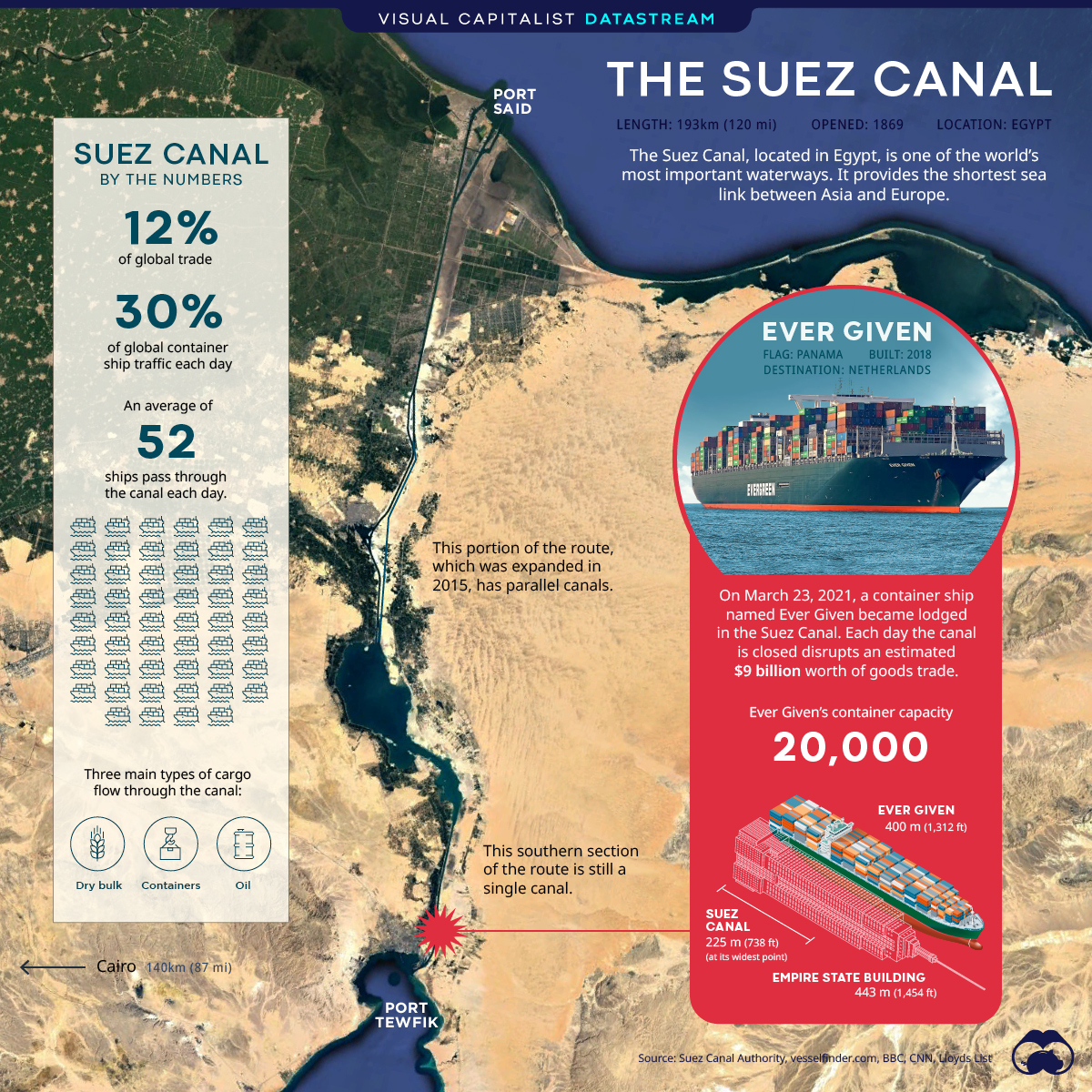Suez Canal: Visualizing The Critical Waterway Now At A Halt
(Click on image to enlarge)

The Briefing
- The Suez Canal is one of the world’s most important waterways, connecting Asia and Europe
- On March 23, 2021, the Ever Given container ship ran aground, blocking transit in both directions
The Suez Canal: A Critical Waterway Comes to a Halt
On March 23, 2021, a massive ship named Ever Given became lodged in the Suez Canal, completely blocking traffic in both directions. According to the Suez Canal Authority, the 1,312 foot long (400 m) container ship ran aground during a sandstorm that caused low visibility, impacting the ship’s navigation. The vessel is owned by the Taiwanese shipping firm, Evergreen Marine.
With over 200 vessels halted on either side of the canal, authorities are scrambling to dislodge the container ship and resume normal operations. This has proven to be a difficult task so far, and experts are warning that the process could take weeks.
What is the Suez Canal?
Constructed in 1869, the Suez Canal is an Egyptian sea-level waterway that provides a vital shipping route between Europe and Asia. Without this route, ships would need to sail around Africa, adding an entire week to their trips.
The connecting link between two important regional economies, the canal facilitates a significant amount of trade. The Suez Canal Authority (SCA) reported that 19,000 vessels—averaging to 52 a day—had sailed through its waters in 2020.
| Year | Number of Vessels | Amount of Cargo (Tons) |
|---|---|---|
| 2011 | 17,800 | 692M |
| 2012 | 17,224 | 740M |
| 2013 | 16,596 | 754M |
| 2014 | 17,148 | 822M |
| 2015 | 17,483 | 823M |
| 2016 | 16,833 | 819M |
| 2017 | 17,550 | 909M |
| 2018 | 18,174 | 983M |
| 2019 | 18,880 | 1,031M |
| 2020 | 18,829 | 1,170M |
The total volume of cargo being transported through the canal has increased steadily in recent years. This includes consumer goods, dry-bulk cargo such as grain and minerals, and oil products.
Implications of the Blockage
The blockage of such an important shipping route is bound to have consequences. According to Lloyd’s List, each day the Suez Canal is closed disrupts over $9 billion worth of goods trade.
European officials have also voiced concern about longer-term impacts, particularly after the blockage is cleared. A sudden influx of ships could cause massive congestion at European ports and further disrupt supply chains.




And what we can see here is that Bigger is not always better. Especially when it comes to failing. Did somebody once say,"The bigger they are, the harder they fall"?
Interesting and with conclusions as well. Is there any consideration that this may be a deliberate action by either an institution or an individual to intentionally disrupt commerce? And with the revelation that the ship is already starting to sag in the middle that nasty suspicion grows stronger. Some problems ARE attributable to malice rather than stupidity. Has the political agenda of those responsible for steering the ship been examined? Perhaps they should be examined.